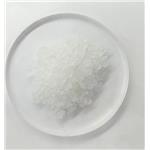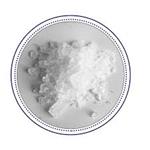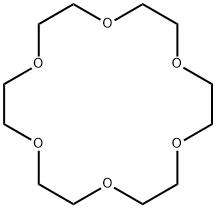18-Crown-6: Applications in Coordinated Metal Halides and Effect on Oxytocin Stability
Jun 14,2024
General Description
18-Crown-6 plays a crucial role in both the enhancement of luminescent properties and nonlinear optical effects in metal halide coordination compounds, including ZnX2(18-Crown-6) and Mn-based complexes. It demonstrates remarkable quantum yields and unique optical properties, influencing electronic interactions within these complexes. Additionally, 18-Crown-6 significantly impacts the stability of oxytocin in aqueous buffers, acting as a stabilizer or destabilizer depending on the buffer composition and pH. This dual role underscores its potential for enhancing peptide stability, offering insights for targeted therapeutic applications in peptide-based drugs.

Figure 1. 18-Crown-6
Applications in Coordinated Metal Halides
18-Crown-6, a versatile crown ether, plays a pivotal role in the synthesis and properties of various coordinated metal halides. The ability of 18-Crown-6 to selectively bind cations, primarily due to its ring structure composed of six oxygen atoms and twelve carbon atoms, makes it an ideal candidate for stabilizing metal ions in a complex. This unique capability is highlighted in the synthesis of compounds such as ZnX2(18-Crown-6), EuX2(18-Crown-6), and Mn-based complexes, where X represents halides like Cl, Br, and I. The research into these coordination compounds, particularly those involving 18-Crown-6, reveals significant advancements in luminescence and nonlinear optical effects. For instance, ZnI2(18-Crown-6) exhibits a remarkably high quantum yield of 54%, indicating its potential in photoluminescent applications. This is an unusual feature for Zn2+-based systems, generally not known for their luminescent properties. Similarly, compounds like EuBr2(18-Crown-6) and EuI2(18-Crown-6) demonstrate quantum yields of 72% and 82% respectively, showcasing the enhancement in luminescence facilitated by the structural configuration of the 18-Crown-6 complexes. Moreover, the Mn-based compounds, such as Mn2I4(18-Crown-6), not only display unprecedented luminescence with a quantum yield of 100% but also exhibit unique optical properties like anisotropic angle-dependent emission and second-harmonic generation (SHG). These nonlinear optical (NLO) effects are attributable to the specific interactions between the metal halides and the 18-Crown-6 ether, highlighting the importance of the ether's role in influencing the electronic and structural characteristics of the complexes. The effectiveness of 18-Crown-6 in these applications is also supported by various analytical techniques, including single-crystal structure analysis, X-ray powder diffraction, and density functional theory (DFT) calculations. These methods provide a deeper understanding of the intricate structures and the dynamic electronic interactions within the 18-Crown-6 coordinated compounds. In summary, 18-Crown-6 serves as a crucial component in the development of metal halide coordination compounds, enhancing their photoluminescent properties and enabling significant nonlinear optical effects. This research not only broadens the scope of applications for 18-Crown-6 but also contributes to the field of materials science with potential impacts in optical technologies. 1
Effect on Oxytocin Stability
18-Crown-6, a cyclic compound known for its ability to complex with various ions, significantly impacts the stability of oxytocin in aqueous buffer solutions. This study delves into how 18-Crown-6 influences oxytocin, a peptide hormone, under different pH conditions and buffer types. Unlike its smaller counterparts, 12-crown-4 and 15-crown-5, which do not affect oxytocin stability, 18-Crown-6 exhibits a unique interaction depending on the buffer's composition. In citrate/phosphate buffers at a pH of 4.5, 18-Crown-6 stabilizes oxytocin. This stabilizing effect is attributed to 18-Crown-6's ability to bind specifically to the protonated ammonium groups within oxytocin, shielding it from degradation. This interaction suggests a protective mechanism where 18-Crown-6 acts as a molecular guard, enveloping oxytocin and enhancing its stability against environmental stresses. Conversely, in acetate buffers at the same pH, 18-Crown-6 shows a destabilizing effect on oxytocin. This destabilization is linked to a potential alteration in the degradation pathway of oxytocin, possibly due to the different ionic interactions in the acetate buffer, which may promote less favorable configurations of oxytocin in the presence of 18-Crown-6. The concentration of 18-Crown-6 plays a crucial role here, as higher concentrations intensify this effect, further destabilizing oxytocin. High-performance liquid chromatography (HPLC) experiments provide additional insights into the interactions between 18-Crown-6 and oxytocin. Changes in the mobile phase, particularly the use of acidic conditions like 0.01% trifluoroacetic acid (TFA), have shown shifts in oxytocin's retention times. These shifts are indicative of binding events between 18-Crown-6 and oxytocin, confirming the hypothesized interaction mechanism. Moreover, ultraviolet and nuclear magnetic resonance spectroscopy further corroborate the significant impact of 18-Crown-6 on oxytocin’s molecular structure and stability. This study underscores the dual role of 18-Crown-6 in modulating peptide stability, highlighting its potential for targeted therapeutic applications where peptide stability is crucial. Understanding the conditions under which 18-Crown-6 stabilizes or destabilizes peptides like oxytocin can lead to more effective formulation strategies for peptide-based drugs. 2
Reference
1. Merzlyakova E, Wolf S, Lebedkin S, et al. 18-Crown-6 Coordinated Metal Halides with Bright Luminescence and Nonlinear Optical Effects. J Am Chem Soc. 2021; 143(2): 798-804.
2. Ghasemisarabbadieh M, Gizurarson S, Sveinbjornsson BR. Effect of 18-Crown-6 on Oxytocin Stability in Aqueous Buffer Solutions. ACS Omega. 2021; 6(8): 5805-5811.
- Related articles
- Related Qustion
- The Synthesis method and Toxicity of 18-Crown-6 May 10, 2024
The compound known as 18-crown-6 is one of the simplest and most valuable of the macrocyclic polyethers.
- 18-Crown-6 coordination compounds: synthesis and properties Jul 3, 2023
18-Crown-6 coordination compounds display intriguing properties in terms of photoluminescence and nonlinear optics.
- 18-Crown-6 - Reaction / Application on Synthetic Works Nov 20, 2019
18-crown-6 (18C6, 18c6, [18]-Crown-6) functions as a ligand for some metal cations, it can solubilize metal salts, particularly potassium salts, in nonpolar and dipolar aprotic solvents. Thus, it is widely used as a phase transfer catalyst.
This review aims to introduce the properties, synthetic methods, uses, and market development of Bis(pinacolato)diboron....
Jun 14,2024APIEctoine is an important natural secondary metabolite in halophilic microorganisms. It protects cells against environmental stressors, such as salinity, freezing, drying, and high temperatures.....
Jun 14,2024Drugs18-Crown-6
17455-13-9You may like
- Sorbic acid: Benefits and Side effects
Jul 19, 2024
- Uses of Sulfanilic acid
Jul 19, 2024
- Sodium Lauryl Ether Sulfate: Applic....
Jul 19, 2024
- 18-Crown-6
-

- $0.00 / 1kg
- 2024-07-10
- CAS:17455-13-9
- Min. Order: 1kg
- Purity: 99%
- Supply Ability: 20tons
- 18-Crown-6
-

- $1.00 / 1g
- 2024-06-11
- CAS:17455-13-9
- Min. Order: 1g
- Purity: 99%
- Supply Ability: 10000
- 18-Crown-6
-

- $10.00 / 1kg
- 2024-04-24
- CAS:17455-13-9
- Min. Order: 1kg
- Purity: 99.6%
- Supply Ability: 100000




